
11/2/6 - 11/11/6
christopher funderburg
In October 2006, Funderburg and Cribbs set out to watch at least 200 movies over the course of the next 200 days. They both watched a different slate of films and wrote about every single one; from epic high art masterpieces such as Max Ophul's The Earrings of Madame de... to lesser films by great directors like Richard Linklater's It's Impossible to Learn to Plow by Reading Books to idiotic dreck like A Night at the Museum. In sections spanning 10 days at a time, The Pink Smoke is reprinting their writings about the grueling experiment in cinematic endurance.
<<click here for 10/23/6 - 11/1/6>>
11.2. Infamous.
(35mm) tech screening at the JBFC
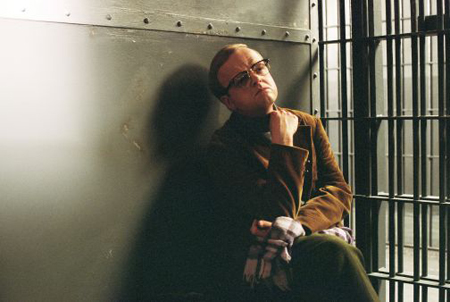 A lot of films aren’t any fun to write about. This is one ofthem. There’s a bunch of boilerplate stuff that needs to be said about
how there’s this other Capote film that covers the exact same territory
as this one and how they’re both remarkably different films with
different actors and different scripts and blah, blah, blah, zzzzzzzzz. If
there were some way to combine both Capote
and Infamous into one big,
not-very-good movie about Truman Capote writing In Cold Blood, then no one would ever have to think about
either of them ever again. As it stands, folks will now occasionally be forced
to think “Hey, weren’t there two overlong, not-very-good movies
about Capote made at virtually the exact same time? Why did they do that?
That’s Hollywood
for ya, I guess.” These two films are like exact mirrors of each other: Capote has the exact virtues which Infamous lacks (good acting, good
production design, good direction, attractive photography) and Infamous has the exact virtues Capote lacks (a coherent/realisticdepiction of Capote as a character, a well-crafted narrative structure).
A lot of films aren’t any fun to write about. This is one ofthem. There’s a bunch of boilerplate stuff that needs to be said about
how there’s this other Capote film that covers the exact same territory
as this one and how they’re both remarkably different films with
different actors and different scripts and blah, blah, blah, zzzzzzzzz. If
there were some way to combine both Capote
and Infamous into one big,
not-very-good movie about Truman Capote writing In Cold Blood, then no one would ever have to think about
either of them ever again. As it stands, folks will now occasionally be forced
to think “Hey, weren’t there two overlong, not-very-good movies
about Capote made at virtually the exact same time? Why did they do that?
That’s Hollywood
for ya, I guess.” These two films are like exact mirrors of each other: Capote has the exact virtues which Infamous lacks (good acting, good
production design, good direction, attractive photography) and Infamous has the exact virtues Capote lacks (a coherent/realisticdepiction of Capote as a character, a well-crafted narrative structure).
Bothhave their share of other individual failings. For instance, Infamous intersperses fake interviews throughout its running time to fill in the blanks and they are a fucking disaster. It also is very intent on playing up the possibility of a homosexual relationship between Capote and the cold-blooded killer played by James Bond, but it kind of pussy-foots around it in a way that feels very tabloid-ish in its insinuations. Worse still, it looks like it was made for $37 and shot by whoever shot Wes Craven’s movies in the 80’s. Other than the guy who plays Capote, the acting is uniformly sub-par – Sandra Bullock is out-and-out embarrassing as Harper Lee (the performance is doubly fucked by being bad in its own right and also paling in the natural comparison to Catherine Keener’s turn as Lee) and Gwenyth Paltrow shows up in a cameo seemingly designed to demonstrate her failings as a chanteuse. Also, leave Peter Bogdanovich out of it. That’s always good advice. However, if you are interested in a more realistic and well-thought out version of the story, Infamous is the way to go. Things that were cloudy, incoherent or just wanted to make you call “bullshit” in Capote are worked through here in believable detail. I’m not sure if that makes this one the better movie – I guess it makes it the truer movie. Maybe I should look at it this way: I can definitely say that Infamous is the suckier movie. And that’s a shame because of what it gets right.
11.3.06. All or Nothing.
(dvd) portable dvd in John Cribbs’ beaten-up Buick.
I don’t understand it - when this movie came out people’s heads should’ve been caving in. Critics should’ve just been like “Shut up! Everybody listen me! Shut up! Go see this movie right now! Shut up, put down whatever you’re doing, get in your car and drive to a movie theater – I don’t care how far you have to go – go see this movie and see it right now! See it right now!” Instead, most people reacted to this film the way I did, “Oh, another Mike Leigh film. Yeah, he’s great. I should see it sometime.” When scholars and academics and other people who are in the habit of looking back on things look back on this period in Mike Leigh’s career, it’s going to blow their minds: Life is Sweet, High Hopes, Naked, Secrets and Lies, Vera Drake, even Topsy Turvy. That’s almost two decades of sustained ultra-genius. It’s like when you look back at Altman in the 70’s and you’re like, “M.A.S.H., The Long Goodbye, McCabe and Mrs. Miller, Thieves Like Us, California Split, Nashville, 3 Women – those movies are fucking beasts! What an amazing period in the career of a filmmaker!” Well, it’s going to be obvious once Leigh makes his Dr. T and the Women or Gingerbread Man that right now, in these years, we’re currently in his heyday: the time when he can just churn out monster after monster of mind-blowing, heart-breaking, soul-shattering original art, disgusting beasts of pure cinema that will devour our cities, scar ourchildren and destroy us all!
 So, anyway, All
or Nothing is that good, but it’s easy to take it for granted
because for two decades now, Mike Leigh is always
that good. It actually makes for a nice companion piece to Life is Sweet and not just because of the
Timothy Spall connection. There’s an unhappy-to-the-point-of-abusiveness
child (this time a tubby, repulsive son instead of a gum-snapping,
greasy-haired daughter), an intimate focus on the minutiae of domestic
interaction, and finally, crucially, an improbably light and witty side
character. In Life is Sweet,
Timothy Spall’s restaurateur lightened up the proceedings considerably
and in the bleak working class world that Leigh so often inhabits, even a small,
twinkling beam of good-humor seems like a freakin’ supernova of joy. In All or Nothing, the woman whose daughter
becomes unexpectedly pregnant is startlingly witty, sunny, and laid-back
– she virtually steals the movie just by being able to crack a joke. Leigh
is insightful enough to see how her humor is both a deflection of the grim
reality as well as the only tool she has for breaking through her
daughter’s hostile shell – but he also makes sure to note how
subtly effective her disposition is. She’s not just a fool who jokesbecause she has no other options: joking around actually works.
So, anyway, All
or Nothing is that good, but it’s easy to take it for granted
because for two decades now, Mike Leigh is always
that good. It actually makes for a nice companion piece to Life is Sweet and not just because of the
Timothy Spall connection. There’s an unhappy-to-the-point-of-abusiveness
child (this time a tubby, repulsive son instead of a gum-snapping,
greasy-haired daughter), an intimate focus on the minutiae of domestic
interaction, and finally, crucially, an improbably light and witty side
character. In Life is Sweet,
Timothy Spall’s restaurateur lightened up the proceedings considerably
and in the bleak working class world that Leigh so often inhabits, even a small,
twinkling beam of good-humor seems like a freakin’ supernova of joy. In All or Nothing, the woman whose daughter
becomes unexpectedly pregnant is startlingly witty, sunny, and laid-back
– she virtually steals the movie just by being able to crack a joke. Leigh
is insightful enough to see how her humor is both a deflection of the grim
reality as well as the only tool she has for breaking through her
daughter’s hostile shell – but he also makes sure to note how
subtly effective her disposition is. She’s not just a fool who jokesbecause she has no other options: joking around actually works.
Since I wouldencourage everyone to see this film right now, today, I won’t delve too deep into the plot. Leigh’s domestic dramas almost always rely on both minor and major revelations and I wouldn’t want spoil the details. But just to contradict myself, also a lot of what I like about his films is their replay value – knowing what’s coming enriches your experience of the narrative before that point. The behaviors which seem dangerous suddenly seem all sound and fury and the small notes of how characters will reveal themselves become almost deafening in retrospect.
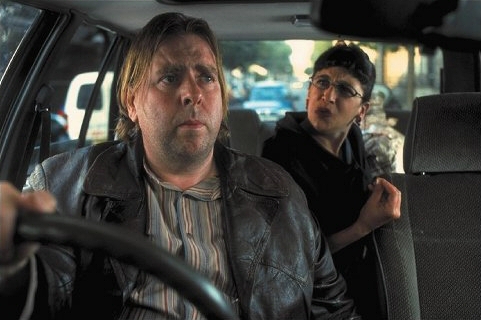 I feel like this write-up, thus far, is strangely impersonal for a filmto which I had such a strong emotional reaction. To me, Mike Leigh is one of
the only filmmakers who successfully addresses the reality of human behavior in
a direct fashion: there are no metaphors, no social analysis, no symbols, no
theories, no themes driving the work in any kind of abstract. Yes, one
undoubtedly gets a strong sense of a greater social/moral agenda when watching
one of his films, but your sense of that agenda is the result of the carefully
observed, deeply felt renderings of love, depression, exasperation, fear, longing,
hope, working, eating, sleeping, waiting, insulting, lying, driving, watching,
snickering and worrying that make up the basic material of his work. The films
are devoid of plot machinations, careless resolutions, convenient coincidences,
forced dialogs, over-written speeches, and knowing winks. More than other
filmmaker I can think of, I look at his films and think “this is life.”
I feel like this write-up, thus far, is strangely impersonal for a filmto which I had such a strong emotional reaction. To me, Mike Leigh is one of
the only filmmakers who successfully addresses the reality of human behavior in
a direct fashion: there are no metaphors, no social analysis, no symbols, no
theories, no themes driving the work in any kind of abstract. Yes, one
undoubtedly gets a strong sense of a greater social/moral agenda when watching
one of his films, but your sense of that agenda is the result of the carefully
observed, deeply felt renderings of love, depression, exasperation, fear, longing,
hope, working, eating, sleeping, waiting, insulting, lying, driving, watching,
snickering and worrying that make up the basic material of his work. The films
are devoid of plot machinations, careless resolutions, convenient coincidences,
forced dialogs, over-written speeches, and knowing winks. More than other
filmmaker I can think of, I look at his films and think “this is life.”
Yes, I also sat in a parking lot in John Cribbs’ car and watched this on my little dvd player as I waited for him to get out of work.
Borat
(35mm) the Crossgates Mall in lovely Albany, New York.
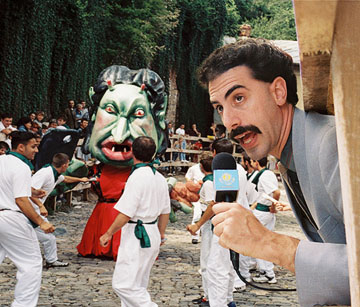 Talking in the “Borat voice” is officially dead. If you say“niiice” or “sexy-time explosion,” you are exactly the
same as the guy who says “yeah, baby!” like Austin Powers. You may
forget, but the first Austin Powers was cool once, too. And so that’s the
only real discussion to be had here: now that Borat is a bona fide pop cultural
phenomenon, what is your relationship to it? Do you tough it out, saying
it’s still cool even if a bunch of dumb jerks who don’t get the
subtleties of the satire are now polluting the mall with their novelty
“#4 Prostitute” and “Don’t Feed Azamat!”
t-shirts? Do you join the backlash, rolling your eyes when Borat is mentioned and
talking about how the satire isn’t actually that deep and that he’s
not doing anything Andy Kaufman didn’t do twenty years earlier? Do you
become a dumb jerk and quote endlessly from the film while almost
hyperventilating from the hilarity? Will you be inspired by the anti-Semitism
to take up arms against the cadre of money-grubbing Jews who are taking overthe Bed and Breakfast industry in the deep South?
Talking in the “Borat voice” is officially dead. If you say“niiice” or “sexy-time explosion,” you are exactly the
same as the guy who says “yeah, baby!” like Austin Powers. You may
forget, but the first Austin Powers was cool once, too. And so that’s the
only real discussion to be had here: now that Borat is a bona fide pop cultural
phenomenon, what is your relationship to it? Do you tough it out, saying
it’s still cool even if a bunch of dumb jerks who don’t get the
subtleties of the satire are now polluting the mall with their novelty
“#4 Prostitute” and “Don’t Feed Azamat!”
t-shirts? Do you join the backlash, rolling your eyes when Borat is mentioned and
talking about how the satire isn’t actually that deep and that he’s
not doing anything Andy Kaufman didn’t do twenty years earlier? Do you
become a dumb jerk and quote endlessly from the film while almost
hyperventilating from the hilarity? Will you be inspired by the anti-Semitism
to take up arms against the cadre of money-grubbing Jews who are taking overthe Bed and Breakfast industry in the deep South?
Whatever Malcolm Gladwell hasto say about it, the tipping point has certainly been passed with this film. When I first saw it a couple weeks ago, I laughed until I busted a gasket and then literally crapped my pants. This time it was still funny, but seeing it in a mall with an audience that I know for a fact to be composed of at least 90% awful people, I’m not sure what I think. It’s a great case study in how an artwork is received and altered by its audience. Who knows if in a month I will hate this film’s guts as well as all of the people mindlessly parroting its choicest and, therefore, most offensive lines? I guess that’s the eternal cycle of pop culture: something authentic is generated outside of the mainstream. It is then co-opted by the mainstream. It is disavowed by the original fans. The new entity grows into something big and self-sustaining. After time the original fans return, pick through the pieces and re-discover the authentic parts. The authentic parts are used generate something outside of the mainstream. It is then co-opted by the mainstream. Repeat.
Notes and news: after the movie, we ate dinner at the Cheesecake Factory. John and I split a B-B-Q Chicken Pizza, “Buffalo Blasts,” and fried Macaroni (which is little fried balls of mac and cheese on a plate of marina sauce). We’re kind of health nuts. Also, I had some cheesecake for dessert and John had a massive piece of chocolate cake with three scoops of ice cream on it. With tip, our meal came to $54. Not bad.
11.4. Driller Killer.
(dvd) my dead grandmother’s old tv, which is now in John Cribbs’ living room in Hudson, NY.
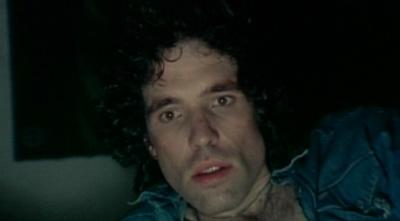 If it is known at all, this film is known for two reasons: 1) Beingdirector Abel Ferrara’s non-porno film debut; and 2) being one of the
centerpiece films in Britain’s
“video nasty” trials along with The
Evil Dead, The Texas
Chain Saw Massacre, and I Spit on
your Grave. Therefore, there are two reasons one might logically be
interested in this film: 1) You want to see of Ferrara’s work in an
embryonic state, what it looked like before it grew up to be The King of New York or The Bad Lieutenant; or 2) you want to see
a film so reprehensible that it inspired an internationally infamous hearing on
censorship, violence and human decency. In either case, I think you’re
going to be a little disappointed. 1) The aimless, under-exposed, under-cooked
film here doesn’t bear much resemblance to Ferrara’s more well-known work, save a
genuinely creepy opening scene at a church. From there, it’s really more
of a documentary about some authentically talentless Bowery band called
“The Roosters.” 2) As an example of vileness and depravity,
there’s really much less murder and/or perversion than one would like
– as I said, the film is really more of a documentary about some authentically talentless Bowery band called “The Roosters.”
If it is known at all, this film is known for two reasons: 1) Beingdirector Abel Ferrara’s non-porno film debut; and 2) being one of the
centerpiece films in Britain’s
“video nasty” trials along with The
Evil Dead, The Texas
Chain Saw Massacre, and I Spit on
your Grave. Therefore, there are two reasons one might logically be
interested in this film: 1) You want to see of Ferrara’s work in an
embryonic state, what it looked like before it grew up to be The King of New York or The Bad Lieutenant; or 2) you want to see
a film so reprehensible that it inspired an internationally infamous hearing on
censorship, violence and human decency. In either case, I think you’re
going to be a little disappointed. 1) The aimless, under-exposed, under-cooked
film here doesn’t bear much resemblance to Ferrara’s more well-known work, save a
genuinely creepy opening scene at a church. From there, it’s really more
of a documentary about some authentically talentless Bowery band called
“The Roosters.” 2) As an example of vileness and depravity,
there’s really much less murder and/or perversion than one would like
– as I said, the film is really more of a documentary about some authentically talentless Bowery band called “The Roosters.”
But what the hell does that mean, “a documentary about ‘The Roosters?’” It means that about 65 minutes of this film’s 90-some-odd minute running time is spent watching “The Roosters” rent a practice space, audition back-up singers, practice their songs, argue about their image, play their gigs, and “get wild!” backstage. Maybe it takes up less of the movie than 65 minutes; but since it feels like it could be as much as 87 minutes of the running time, I thought I was being generous. I couldn’t discern whether or not “the Roosters” were a real band or just made up for the movie, but I can assure you they are terrible. The ostensible plot of the movie revolves around a frustrated asshole (who also happens to be a painter) played by Jimmy Laine (aka Abel Ferrara himself). At first I thought, “Jesus, why did they get such an ugly dude to play the lead?” And then, "Now he’s making out with the hot lead actress again. He must be Abel Ferrara.” Jimmy Laine’s performance as "Reno the frustrated asshole" is all mumbles and shouts, it’s a like a “Best of” compilation of amateurish acting tics. Anyway, Reno is trying to finish his masterpiece but his bisexual middle-aged girlfriend and (apparently) mentally-retarded hipster chick roommate are all on his back and tired of being poor, so everybody gets excited when they can get free tickets from “The Roosters” to see them in concert. There are just so many distractions for Reno preventing him from finishing his masterpiece - it’s like they’re driving him insane.
The drill killings are shoehorned into this film like every distributor in the world told Ferrara his movie about a frustrated artist was undistributable and only then did Ferrara decide to turn it into a slasher pic. Aside from the big ending, only completely superfluous, disposable non-characters like hobos and subway patrons are drilled. Reno does the drilling, I guess, as a way of taking out his frustrations. It’s not totally clear why he goes after the hobos and not “The Roosters” or his girlfriend. The film also goes to great pains to set up the amazing scientific break-through, the “porto-pak” – a portable power source which enables Reno to commit the drill killings. I, for one, looked at the box of the film and was all like, “Drill killings? They didn’t have portable drills in 1979!” Of all of the hopelessly boring films I’ve seen, this one ranks among the most interesting: if inexplicably compelling weirdness is a talent, Ferrara was definitely blessed with it. Side note: the most upsetting thing in Driller Killer is some pizza Reno, his roommate and his girlfriend are eating in one scene. It’s not supposed to be gross or anything, it’s just supposed to be pizza. But, holy cow, it is nightmarish. If pizza could look like it had rotted, this is what it would look like. Only greasier. When a piece gets flung in Ferrara’s face, I almost vomited.
Flushed Away.
(35mm) the 8 screen theater in Hudson, NY.
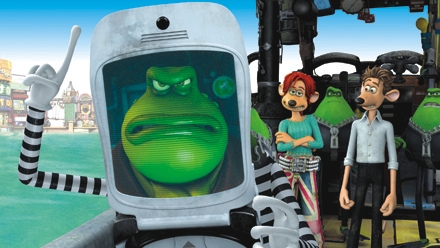
Of all of the contemporary animation production companies, I think I like Aardman the best, probably even better than Pixar. Certainly, I like the “Wallace and Gromit” films more than I like any individual Pixar creation. Disney’s hand-drawn division is dead and hadn’t made a great film for years, anyways. The “3-D” films churned out by companies like Dreamworks (Shrek 2, Madagascar) and Sony (Monster House) are negligible. So, I kinda had my hopes up for Aardman Animation’s Flushed Away - maybe not too high, but I was hoping for something a cut above the rest of the pack. If I were in a forgiving mood, I could imagine saying some nice things about Flushed Away, but the fact is that it suffers from exactly the same problems that make so much recent animation hard to endure. It has a “rockin’” soundtrack overpopulated with today’s (or really, last week’s) blandest hits, a bland spunky female character, an emphasis on bland brand-name stars who are not necessarily talented at voice-acting, and bland retreads of cartoon conventions that have been in regular (over-)use since Chuck Jones, Tex Avery and Fritz Freleng invented them in the 40’s. It’s not bad, per se, and it features a couple bits that approach greatness (the mime frog with a cell-phone face, for example), but it really never does too much to set itself apart from the pile of other films about wisecracking, anthropomorphic animals who learn the true meanings of friendship and selflessness.
The Marine.
(35mm) the 8 screen theater in Hudson, NY.
 Do you want to see professional wrestling/rapping sensation John Cenakick some scummy meth dealer in head? Of course you do! But what to do in the
meantime, when the plot is happening? We can’t just leave Cena on screen,
all helpless up there with nothing but the magic of “acting” to
save him! Get me Robert Patrick. ROBERT PATRICK! If you have an ounce of love
for b-action movies, this great film will go straight to your heart and nestle
there gently like a baby angel or a handicapped puppy. Here’s set-up:
being a marine is all John Cena knows, so when he’s discharged for disobeying a direct order (!!!),
he’s a lost in an indifferent world with no use for his extensive
knowledge of demolition devices and hand-to-hand combat expertise. But Sarge,
you can’t do this to me, being a marine is all I know! Maybe next time,
Cena will have learned to wait for back-up before charging into the Al Qeada
compound and saving those prisoners his own
damn self! Stupid Sarge!
Do you want to see professional wrestling/rapping sensation John Cenakick some scummy meth dealer in head? Of course you do! But what to do in the
meantime, when the plot is happening? We can’t just leave Cena on screen,
all helpless up there with nothing but the magic of “acting” to
save him! Get me Robert Patrick. ROBERT PATRICK! If you have an ounce of love
for b-action movies, this great film will go straight to your heart and nestle
there gently like a baby angel or a handicapped puppy. Here’s set-up:
being a marine is all John Cena knows, so when he’s discharged for disobeying a direct order (!!!),
he’s a lost in an indifferent world with no use for his extensive
knowledge of demolition devices and hand-to-hand combat expertise. But Sarge,
you can’t do this to me, being a marine is all I know! Maybe next time,
Cena will have learned to wait for back-up before charging into the Al Qeada
compound and saving those prisoners his own
damn self! Stupid Sarge!
Fortunately after a couple scenes to set things up, Cena is shuttled to the side in favor of Robert Patrick’s band of precociously amoral jewel thieves. When their plan to shoot two police officers to death at a gas station and then blow it up somehow goes awry, they take Cena’s perky young blonde wife as a hostage instead of killing her indiscriminately (which to that point had been their M.O.) Wrong move, Patrick: Cena’s a marine. Well, we’ll just shoot his car to pieces during an extended chase through a poorly secured construction site! But Cena can’t stop, won’t stop! Says big black henchman: “That guy’s like the Terminator.” Ah, the mot juste! Patrick raises an eyebrow sarcastically. Will Mr. Patrick’s dark-haired bitchy lady-friend get in a cat-fight with Cena’s plucky and resourceful young blonde bride? I won’t spoil the ending for you, but suffice it to say Cena tackles someone through a large cement pillar. If I haven’t sold you yet, this movie also has an absolutely brilliant aside where Patrick hits on Cena’s wife. It’s fucking priceless. Seriously, go see this movie before it’s too late because there’s absolutely no way Spike TV will be playing this every Saturday afternoon at 2:00pm for the next six years.
11.5.06. One Crazy Summer. (commentary track)
(dvd) my grandmother’s former tv, now in John Cribbs’ living room.
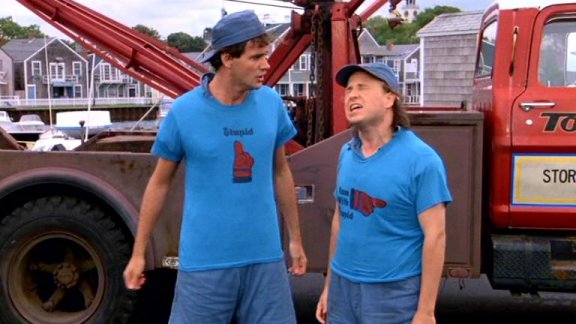
“My fiancée of three years saw it when see was eight. She said, someday I’m going to grow up and marry Egg Stork.” A great commentary track with the director Savage Steve Holland, Curtis Armstrong (“Ack-Ack” in One Crazy Summer, but certainly most famous for playing “Booger” in Revenge of the Nerds), and Egg Stork himself (Bobcat Goldthwait). I’m not sure what their actual relationship is, but the commentary has a great feel of three friends sitting around cracking jokes, talking smack and trying to recall half-forgotten details. For some reason, Savage Steve is really hard on the film and the overall tone is one of slight embarrassment mixed with an unmistakable fondness for the project – it’s like the commercial failure of the film tainted it somehow, but they still like it (Hollywood executives be damned). Anyway, the track actually has a nice balance of joking around (which makes it no chore to sit through) and interesting informational tidbits. Bobcat actually filmed the excellently stupid movies-within-a-movie (Hemorrhoid from Hell and Chainsaw Date), Mark Metcalf is very cranky, Demi Moore was cast over the phone based on just her voice, Savage Steve’s sister is really named “Squid,” and Emilio Estevez liked to hang out with Nikki Sixx. Throughout the track, there are several breaks in the commentary that last a minute or two and it’s clearly when they’re discussing John Cusack. Apparently, Cusack hated the film and halfway through production decided he hated Savage Steve and stopped talking to him, so the lawyers at Warner Bros. erred on the side of not further irritating Cusack (20 fucking years later) and cut out any controversial mention of him from this commentary track. Seriously, his name comes up maybe three times and it’s all in the context of laughing derision. The Cusack foibles aside, I’d rank it up there among the most compulsively listenable commentary tracks of all time alongside the Raimi/Campbell tracks, the Mallrats commentary, and James Woods’ hyperactively academic dissection of Videodrome.
Lair of the White Worm.
(dvd) the tv in John J. Cribbs’ living room.
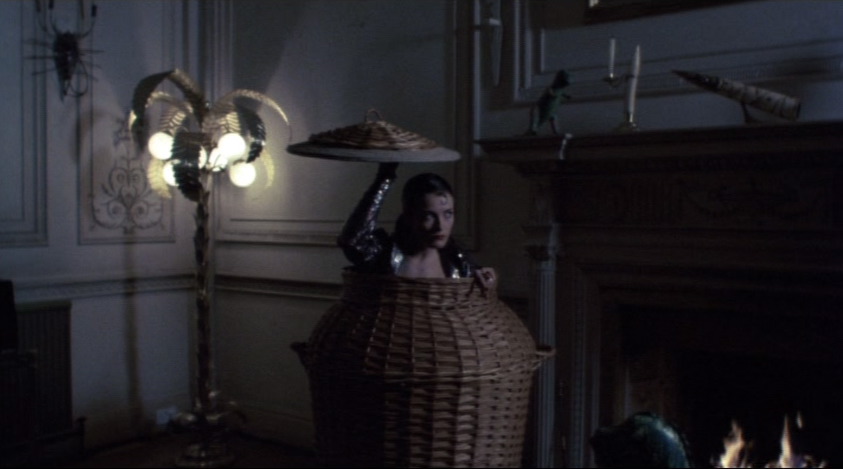 This was a netflix dvd that was apparently left over from John’s“all horror, all the time” October agenda. Maybe he just rents (is
it called “renting” from netflix?) horror movies a ratio of 8
horror film to 1 regular movie? Anyway, John and I were discussing what
happened to Ken Russell – he went from being a big-shot auteur who makes
films about classical musicians and personifies the whole “camp gay
revisionist” sensibility to being an ultra-hacky b-movie director. Did
that happen because his long-time collaborator Derek Jarman died? Or were those
two realms never really that far away to begin with? Lair is firmly entrenched in the hack period, although there
are still plenty of unmistakably Russell-ish moments in the story of a giant
demonic worm (or “wyrm” or “serpent” or “big
snake”) that is awakened by archaeologists digging around where they shouldn’t.
This was a netflix dvd that was apparently left over from John’s“all horror, all the time” October agenda. Maybe he just rents (is
it called “renting” from netflix?) horror movies a ratio of 8
horror film to 1 regular movie? Anyway, John and I were discussing what
happened to Ken Russell – he went from being a big-shot auteur who makes
films about classical musicians and personifies the whole “camp gay
revisionist” sensibility to being an ultra-hacky b-movie director. Did
that happen because his long-time collaborator Derek Jarman died? Or were those
two realms never really that far away to begin with? Lair is firmly entrenched in the hack period, although there
are still plenty of unmistakably Russell-ish moments in the story of a giant
demonic worm (or “wyrm” or “serpent” or “big
snake”) that is awakened by archaeologists digging around where they shouldn’t.
Hugh Grant plays a foppish dandy intent on getting to the bottom of the mysterious disappearances that having been plaguing the town while Catherine Oxenberg is placed in various situations where she can stand around in her underwear looking totally uncomfortable with the whole project. Amanda Donohoe plays the white wyrm’s vampish assistant and she really gives it her all, cavorting around totally naked and painted blue. There’s a great scene where a pimply Boy Scout (or whatever they're called in England) interrupts her exceedingly awkward attempt at seduction by playing snake-charming music on a harmonica and she can’t help but do a wiggly dance in response – because she’s a snake-lady! It’s such an odd scene and Donohoe throws herself into it with such an aggressive conviction that she ends up straddling then mounting then ravaging the border between“admirable” and “embarrassing.”
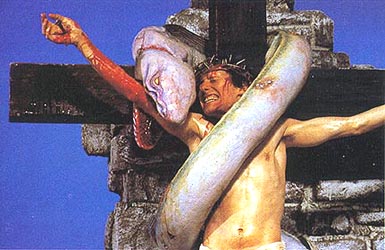 More importantly, there’s a bit early on in the film which is possibly the most Russell-ish moment in anyof his films: Oxenberg touches a crucifixand and is immediately blasted (by
Christ-magic?) backwards into a wall and concussed. From there she has an
extended hallucination in which Roman soldiers rape a boatload of nuns while a
giant white serpent leers from above, entwined on a giant crucifix. All of this
is filmed over a low-fi psychedelic background in orchestration with a screeching
synthesizer score. The whole jaw-dropping scene streaks in from out of nowhere
and you immediately think, “Oh yeah, this is the dude who made Lisztomania.” Second prize for most
Ken Russell moment goes to Hugh Grant’s dream sequence where he watches
two stewardesses leg wrestle in garter belts and then erects a pen in his lap
in a head-slappingly literal visual metaphor.
More importantly, there’s a bit early on in the film which is possibly the most Russell-ish moment in anyof his films: Oxenberg touches a crucifixand and is immediately blasted (by
Christ-magic?) backwards into a wall and concussed. From there she has an
extended hallucination in which Roman soldiers rape a boatload of nuns while a
giant white serpent leers from above, entwined on a giant crucifix. All of this
is filmed over a low-fi psychedelic background in orchestration with a screeching
synthesizer score. The whole jaw-dropping scene streaks in from out of nowhere
and you immediately think, “Oh yeah, this is the dude who made Lisztomania.” Second prize for most
Ken Russell moment goes to Hugh Grant’s dream sequence where he watches
two stewardesses leg wrestle in garter belts and then erects a pen in his lap
in a head-slappingly literal visual metaphor.
Tourist Trap.
(dvd) the tv in John Cribbs’ living room. There is a streak of wax running down the side of the screen.
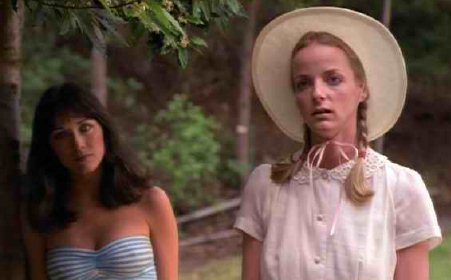
A friend of John’s recommended this crap-fest and I have no ideawhy we watched it all the way through. From the first five minutes, you can tell it’s going to suck. To really, really suck. Once again, it’s the Texas Chain Saw Massacre template: youngsters have car trouble in a remote area, there’s a run-in with a local yokel who will turn out to be their future killer, mayhem ensues, and I alone lived to tell the tale. The mayhem is always the crucial element and in this case, it’s a bunch of creepy-looking (actually more “crappy” than “creepy”) mannequins that may or may not be possessed along with a telekinetic farmer with a fetish for being intensely boring. The film has absolutely awful special effects, which wouldn’t be a problem if the film didn’t place such an emphasis on effects-based scares involving cackling dummies, masked assailants, mutilations and objects flung about by a dude’s thoughts. All of these things look more than faintly ridiculous and it’s hard to be afraid of The Rifleman when the worst he has in his repertoire of terror is causing mannequins to jiggle slightly. Worse yet, the film relentlessly keeps up this pretense that the identity of the killer is somehow a mystery – the whole things builds to lame reveal that’s basically a tired (beyond tired, actually – catatonic?) rip-off of Psycho. Honestly, the most interesting thing about the film is Tanya Robert’s tube top and, to be fair, it’s riveting.
11.6. Lost in America.
(vhs) still at John’s house. I could also mention that my grandmother’s old tv is sitting on a tv stand that I bought from Ikea and used for the tv when John and I lived together in White Plains. I believe he may have some of my other furniture/appliances as well.
On Sunday, John and I went to the Hollywood Video in Hudson because they were liquidating their VHS stock and you could get ten movies for $10 and then every movie purchased in addition to the initial ten was just a $1. So, I picked up this copy of Albert Brook’s Lost in America – it doesn’t have an actual cover, just a little black and white label that reads “Lost in America” in innocuous type with no other information. I guess I was going out on a limb in assuming that it was actually Albert Brooks’ Lost in America and not a documentary about hapless campers in Missouri or something. Here’s the complete list of films I picked up (with this freakin’ blog in mind, I tried to grab a bunch of things I hadn’t seen already): Scarecrow (with Gene Hackman and Al Pacino), And Now For Something Completely Different, Benoit Jacques’ School of the Flesh with Isabelle Huppert, The Newton Boys (which I’ve never seen and Linklater vigorously defends), In the Heat of Passion II: Unfaithful, Code 46 (once again, I am suckered by Winterbottom), Lost in America (of course), One False Move, and Peyton Reed’s seminal Down with Love. John got a movie called 3-Way with Ali Larter and Gina Gershon. It was probably the soundest purchase of the day.
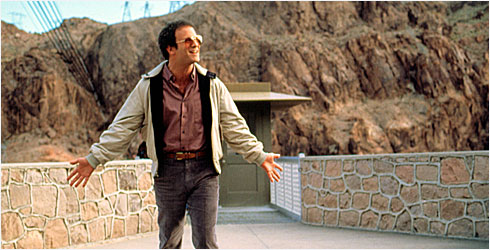 Anyway, when we were watching Lost
in America, Cribbs remarked that it was strange that Albert
Brooks’ films aren’t more fondly remembered – and he’s
right; they’re not even really footnotes in the history of cinema.
What’s striking about Lost in America
(and the other early Brooks’ films Modern
Romance and Real Life)
is how they’re very mainstream comedies on the one hand, but on the other
hand they’re fairly high-minded and approaching some kind of quality that
could be construed as art. Granted, I am essentially the same person as Albert
Brooks’ characters in these movies, so I may have a bit more of a
personal response to the material, but I feel like these films frequently
transcend the cheap jokes and comedic sketches that are their reason for being.
When Albert Brooks quits his job, that’s me and my behavior represented
onscreen in a fairly literal way and, as a result, the scene resonates with me
in a fashion that most broad comedies never do: the film has an authenticity of
behavior that never feels like it exists just to set up a gag. It’s like
the best Woody Allen stuff or what I imagine Elaine May thought she was doing
with Mikey and Nicky.
Anyway, when we were watching Lost
in America, Cribbs remarked that it was strange that Albert
Brooks’ films aren’t more fondly remembered – and he’s
right; they’re not even really footnotes in the history of cinema.
What’s striking about Lost in America
(and the other early Brooks’ films Modern
Romance and Real Life)
is how they’re very mainstream comedies on the one hand, but on the other
hand they’re fairly high-minded and approaching some kind of quality that
could be construed as art. Granted, I am essentially the same person as Albert
Brooks’ characters in these movies, so I may have a bit more of a
personal response to the material, but I feel like these films frequently
transcend the cheap jokes and comedic sketches that are their reason for being.
When Albert Brooks quits his job, that’s me and my behavior represented
onscreen in a fairly literal way and, as a result, the scene resonates with me
in a fashion that most broad comedies never do: the film has an authenticity of
behavior that never feels like it exists just to set up a gag. It’s like
the best Woody Allen stuff or what I imagine Elaine May thought she was doing
with Mikey and Nicky.
The film has real structural problems, though, and it ends so abruptly that you can’t help but feel a little gypped. At the end, they just kind of decide to make their problems go away and the film doesn’t resist – it makes you feel like the characters really haven’t been through anything and it has the unintended effect of making the film feel totally trivial. I’m not saying they should end up in a crack house sucking dick for spare change or anything, but, jesus man, the resolution needs to feel a hell of a lot less like an afterthought. It makes me curious about Brooks’ creative process because the same kind of tonal imbalances and narrative hiccups mar all three of those otherwise great early films. Does he just write a bunch of sketches and then throw them together without much consideration for how they’ll fit together? Because that’s what it sure feels like. Nevertheless, every individual scene is pretty great and I spent the rest of the day asking John if he had “a white collar box, maybe? One where you keep the good jobs, kind of off to the side?” For his part, John just kept repeating “22!” with a wild look in his eyes and then asking me if I wanted to watch the trailer for The Number 23 with Jim Carrey again. Ok, that might not have happened. Certainly not for “the rest of the day.” I should also mention that Julie Haggerty is fantastic in Lost in America and she has to be in the pantheon for under-rated/ unfairly forgotten comedic actresses. I hereby decree it!
11.7. Pan’s Labyrinth.
(35mm) Jacob Burns Film Center
Guillermo Del Torro has always been a director whom I’ve liked more than his movies. When I think of his work, I realize that my favorite of his films is probably Blade 2 and that seems little odd. Am I really that into a guy whose best work the sequel is a sub-par Wesley Snipes vampire-hunting vehicle? Hellboy probably runs neck and neck with Blade 2 as far as overall quality, but it suffers from plenty of glaring problems such as the ultra-cheesy villain and too many hardy-har-har one-liners. All of his films though have plenty of great individual scenes and impressive visual ideas even if they don’t necessarily add up to laudable wholes. Even the bug creatures in Mimic are pretty cool, even if that movie otherwise sucks. Devil’s Backbone and Cronos both seem like they should be much better movies than they actually are and Pan’s Labyrinth is undoubtedly part of that branch of Del Torro’s evolutionary tree: the art/horror film that never quite works as a horror film nor achieves the status of high art. Unfortunately, Pan’s is also not an especially original idea: a young girl seeks refuge in a world of fantasy in order to deal with the real world horrors surrounding her.
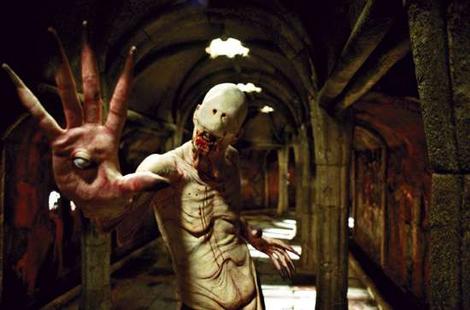
That said, it’s definitely a cut above Devil’s Backbone and Cronos – it’s frequently very effective as both fanstasy/thriller and a political allegory. One the fantasy side of things, once again, he delivers big-time in the creature fx department: both the Faun and the Pale Man are fantastic creations. The Pale Man in particular is as disturbing a bit of creature make-up as I can remember having seen since the dudes in the original Hellraiser – the film is worth seeing for his feast sequence alone. As a matter of fact, all of the fantasy sequences look gorgeous and are a perfectly mixed concoction of dread and wonder. It’s the reality side of the film that trips up the proceedings, though. The brutal Captain (who is the girl’s stepfather and the leader of the Fascist brigade at the center of the film) is even more cartoon-ish than any of the fairy-tale creatures. Generally speaking, virtually every character in the film is under-drawn and paper-thin. The film’s fetish for violence and revelry in brutality makes for some uncomfortable moments: things that should be upsetting are simply too cool-looking to be received with anything than mild exhilaration. The films revels in its effects in the “real” world in the exact same way it does so in the "fantasy” world of the young girl and that queasy imbalance (along with the weak characterization) severely undermines whatever deeper meaning the film wants to express – it repeatedly seems more caught up in how strikingly neat-o it looks for a man to be shot in the face at close range than in the sober look at senseless brutally that would ostensibly justify lingering on a coup de grace or a mangled hand. Also, the film builds to a false ending that’s more than a little irritating – you know, for a second there, I was worried the Fascists might win and rule Spain for the next thirty years. I don’t want to seem like I hated this film (because I definitely liked it), I just want to make clear that it’s a fitting entry in a career full of near misses.
11.8. Nothing.
This is the first day I haven’t managed to see anything for the blog. Maybe I didn’t see a movie today, but I did fall in love with a burrito.
11.9. The Newton Boys.
(vhs) the tv in my apartment.
So, two things: a) this movie probably got a raw deal when it came out and isn’t as bad as the virulent reviews it got; and b) this movie has some serious problems and isn’t so great. I can actually sympathize with Linklater here; I’ve read a few interviews where he kind of sticks up for this film and speaks fondly of it. It’s a pretty gentle and laid-back affair and I can imagine it was a lot of fun to make. It certainly doesn’t deserve to be remembered as a piece of worthless shit, which I think is pretty much the consensus at this point. So here’s the good: an amazing set-piece revolving around a botched robbery in Toronto, lots of worthwhile film-buff savvy in-jokes, the pleasantly meandering quality of Linklater’s other films and some priceless video footage of the actual Willis Newton over the end credits. The botched robbery in Toronto is the only thing in the film that will remind you even vaguely of other bank heist films – The Newton Boys is strikingly devoid of the urgency and tension which is the genre’s stock-in-trade. The robberies all come off with only the mildest of hitches and they all have a pacing that makes them seem like nobody involved is in a hurry and there’s no reason why they should be. After I got used to the ho-hum quality of the heists, it felt nice to be settled in the ebb and flow of the seemingly aimless narrative. You keep thinking something is going to raise the stakes, but such a twist never really materializes. Even the conflict between chief-robber Matthew McConaughey and his unsuspecting gal Julianna Marguiles – which from the beginning seems set up for a blow-up – ends up being a non-starter. He reveals his secret identity as a bank-robber, she’s irritated for about two seconds, and then things settle back to normal.
So when the bank robbery goes awry in Toronto, it’s not only shocking that something is actually happening, it’s shocking how the sequence is played with a precarious balance of comedy and menace – it’s both amusing and terrifying and quickly bounces back and forth between those two polarities. I’d say if you like Linklater or bank-heist films, that the Toronto sequence alone justifies a perusal of this movie. After that, it settles back into a lazy pace and even their final big score and attendant undoing doesn’t generate much heat. Although, I’d say that’s more by design than a failure of execution – the film is perfectly content to hang around with the cadre as they spend their money, seduce women, goof off and act like, well, brothers. In regards to the film in-jokes, it gives a nod to (but doesn’t lean too hard on) silent era camera tricks and also references a couple classic heist films without going overboard with “spot the reference;” so I was frequently engaged on that level without being irritated by the cleverness.
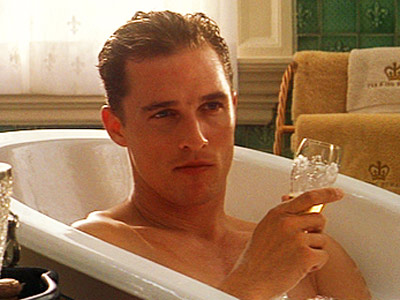 So the bad? Well, the cast is my living nightmare, an absolute litany oftalentless jack-asses who the studios were trying to force on audiences back in
1998: Matthew McConaughey, Skeet Ulrich, Julianna Margulies, Ethan Hawke, I
even think Vincent D’Onofrio is more of a minus than a plus in most cases.
Since 1998, Hawke has done just enough to get into the black with me (in
Linklater’s Sunset films and
Tape), but I still don’t
want him thinking we’re pals or anything. That cast alone is giant
obstacle to overcome and the film can’t get around McConaughey’s
smarmy, off-putting persona or Ulrich’s total lack of screen presence. When
one of the four main characters doesn’t even register, you’re
probably in insurmountable trouble. In addition, D’Onofrio gives a
typically mumble-y, mannered performance and all of the “whootin’
it up!” in the world can’t make Hawke’s character into
anything more than a one-dimensional cad. Plus, Marguiles and McConaughey seem
like they can scarcely mask their hostility for each other. The scenes in which
they are called on the yell at each other are the only ones through which they
don’t sleepwalk. The other huge problem, which bothered me from the
get-go, is the hopelessly unconvincing set design. The whole thing feels like
very expensive dress-up, a movie-ish polish on everything and no attention to
the kind of details that sell a period setting. It doesn’t help that the
actors are as out of place as Christian Slater in medieval England and their
hairstylist’s primary concern was making them look like squeaky-cleanpoofters.
So the bad? Well, the cast is my living nightmare, an absolute litany oftalentless jack-asses who the studios were trying to force on audiences back in
1998: Matthew McConaughey, Skeet Ulrich, Julianna Margulies, Ethan Hawke, I
even think Vincent D’Onofrio is more of a minus than a plus in most cases.
Since 1998, Hawke has done just enough to get into the black with me (in
Linklater’s Sunset films and
Tape), but I still don’t
want him thinking we’re pals or anything. That cast alone is giant
obstacle to overcome and the film can’t get around McConaughey’s
smarmy, off-putting persona or Ulrich’s total lack of screen presence. When
one of the four main characters doesn’t even register, you’re
probably in insurmountable trouble. In addition, D’Onofrio gives a
typically mumble-y, mannered performance and all of the “whootin’
it up!” in the world can’t make Hawke’s character into
anything more than a one-dimensional cad. Plus, Marguiles and McConaughey seem
like they can scarcely mask their hostility for each other. The scenes in which
they are called on the yell at each other are the only ones through which they
don’t sleepwalk. The other huge problem, which bothered me from the
get-go, is the hopelessly unconvincing set design. The whole thing feels like
very expensive dress-up, a movie-ish polish on everything and no attention to
the kind of details that sell a period setting. It doesn’t help that the
actors are as out of place as Christian Slater in medieval England and their
hairstylist’s primary concern was making them look like squeaky-cleanpoofters.
But from the start you’re never in the world of the film because it really doesn’t feel like the 1920’s - let alone the peculiar convergence of the old and the new that was the mid/West Texas in that timeframe, a place where people rode on horseback and dressed like cowboys while planes flew overhead and gangsters dressed in pin-stripe suits. I was so frustrated by the production design, I sought the designer out in the credits to keep that name in my mind as a source of ire. Wouldn’t you fucking know it? It was Catherine Hardwicke of Thirteen and Lords of Dogtown fame. I’m glad her shitty touch extends to not only hyperventilating morality plays about troubled teens, but also the production design on Linklater’s two worst films: SubUrbia and The Newton Boys. I’d like to go ahead and officially blame her for those films’ faults. Is that fair?
11.10. In the Heat of Passion 2: Unfaithful.
(vhs) the tv in my apartment.
Because of the seminal first installment in the In the Heat of Passion series, I had great expectations for this work (perhaps impossibly so). If you were ever curious as to just who were the folks in my “heroes” section of this profile;* with IHOP, at least part of the riddle is answered. The great Rodman Flender created a trilogy of straight to video hits in the early 90’s that is heretofore unmatched in the realms of pure cinema: The Unborn, IHOP, and Leprechaun 2: One Wedding and Lots of Funerals. I’ll spare you too much of a reverie on these films (because this post is theoretically about IHOP 2: Unfaithful) and just briefly recap the plot of the first IHOP. It follows a struggling actor who gets cast as a rapist in an “America’s Most Wanted”-style bring-‘em-to-justice show, but his day job is laying cable - if you know what I mean and, in this film, Sally Kirkland certainly finds out. So, this cable-tv repairman/actor ends up being seduced by Sally Kirkland, but it turns out (as in all erotic thrillers) he’s actually being set up for nefarious purposes. You might say thatwhat starts out as a sexy game of erotica unexpectedly turns deadly.
 Ok, so IHOP 2: Unfaithful has only the most
tenuous connection to that film. The great Rodman Flender did not return to turn up the
heat on the passion. There’s no struggling actor/cable-tv repairman and
no Sally Kirkland. But there is Lisa Kurdow again. Yup, Lisa Kudrow has a small
role in both of Passion films and I couldn’t really decide if she was supposed to
be playing the same character or not. For one, I couldn’t remember what
she played in the first one (I just remembered that both she and Carl Franklin turn
up in it) and her role is less than a minute long in numero dos, so it seemed
weird to bring her back intentionally. It was probably more of a cosmic
coincidence, a small harmonic convergence which creates order out of chaos.
Actually, there are a lot of sitcom stars in IHOP2:
Kudrow, “Family Ties’” Michael Gross and it even stars Barry
Bostwick of "Spin
City" fame. Yeah,
so no cross-over on the cast or director or creative forces or anything. I
guess the plot could be contorted to maybe remind you of the first one. Maybe.
In 2, with the help of his
step-daughter, Barry Bostwick murders his wheelchair bound wife. His
motivation: to pursue a sexy game of erotica with said step-daughter. But will the game suddenly turn deadly?
Ok, so IHOP 2: Unfaithful has only the most
tenuous connection to that film. The great Rodman Flender did not return to turn up the
heat on the passion. There’s no struggling actor/cable-tv repairman and
no Sally Kirkland. But there is Lisa Kurdow again. Yup, Lisa Kudrow has a small
role in both of Passion films and I couldn’t really decide if she was supposed to
be playing the same character or not. For one, I couldn’t remember what
she played in the first one (I just remembered that both she and Carl Franklin turn
up in it) and her role is less than a minute long in numero dos, so it seemed
weird to bring her back intentionally. It was probably more of a cosmic
coincidence, a small harmonic convergence which creates order out of chaos.
Actually, there are a lot of sitcom stars in IHOP2:
Kudrow, “Family Ties’” Michael Gross and it even stars Barry
Bostwick of "Spin
City" fame. Yeah,
so no cross-over on the cast or director or creative forces or anything. I
guess the plot could be contorted to maybe remind you of the first one. Maybe.
In 2, with the help of his
step-daughter, Barry Bostwick murders his wheelchair bound wife. His
motivation: to pursue a sexy game of erotica with said step-daughter. But will the game suddenly turn deadly?
Some actress I’ve never seen before or since plays the step-daughter and she’s not nearly as attractive as the scantily-clad model on the video box cover. She also blatantly uses a body double in the naked parts (of which there are plenty) and it’s funny to see this phenomenon in full effect: did this used to work on people? Yeah, yeah, everybody knows all about this "industry secret" nowadays, still - it’s so freaking transparent that I can’t believe it ever worked. Maybe men are so simple and yield so much to immediate necessity that the deceiver never lacks dupes.... or maybe, at the end of the day, all that matters is that a naked boob is a naked boob, regardless of what character or actress it is supposedly attached to. So, the actress who is not naked or on the video box isn’t very appealing and the whole thing has nothing to do with the first one (god bless you, Roger Corman) but there’s something about the film that rings true. This chick and Bostwick are both good enough actors with a vapid enough script that you end up with what feels like a fairly accurate depiction of what it’s like to spend an hour and a half with very rich, annoyingly self-absorbed people. He’s a button-down yuppie type living in the Hollywood hills and they hang around their swimming pool having boring sex and thinking their emotions are way more intense than they actually are. They really reminded me of the rich people I know. I suspect this is just a side-effect of the incompetent filmmaking more than an intentional strategy, but still, I’d say - as far as its understanding of rich jerks - it’s as authentic as The Leopard. I hope someday I am very famous and influential and they release a special edition of this film with that quote on the box: “ as authentic as The Leopard– C. A. Funderburg.” That would certainly be no less ridiculous than those fucking editions of Switchblade Sisters and Master of the Flying Guillotine withTarantino’s name and praise all over the box.
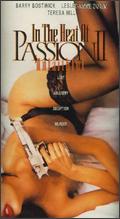 So, I know I’ve given you a lot to mull over already, but what’s really most notable about thefilm is its depiction of mid-90’s youth culture. There’s a big reveal
about half-way through the movie that the step-daughter is really playing Barry
Bostwick for a sucker and we get to see what her life is really like:
she’s not a yuppie at all! She goes to a seedy bar in a maroon crushed
velvet dress with black stockings and Doc Martins and white socks and
there’s a band playing there that looks like Warrant but sounds like
KMFDM. It was startling. It was accurate about the youth culture in a way that
only a film that is totally clueless could be; it was pitch perfect re-enactment
of the cultural product vigorously marketed to me in my adolescent years,
half-90210, half-“My So-Called Life,” all dudes in flannel shirts
with faded jeans and guys who look just like Matt Dillon in Singles. It was awful. I wanted to go back to Barry Bostwick’s
house and pretend like 1994 never happened. That’s actually a nice trick
the movie pulls: it will have you rooting for a guy who murdered his wheelchair
bound wife in order to seduce his step-daughter. If you ever get a chance, pick
up the box and really read the description on the back (don’t just ingest
the signifiers like “sexy," "deadly,"
"deception," and "erotica.") – the description literally
doesn’t make any sense.
So, I know I’ve given you a lot to mull over already, but what’s really most notable about thefilm is its depiction of mid-90’s youth culture. There’s a big reveal
about half-way through the movie that the step-daughter is really playing Barry
Bostwick for a sucker and we get to see what her life is really like:
she’s not a yuppie at all! She goes to a seedy bar in a maroon crushed
velvet dress with black stockings and Doc Martins and white socks and
there’s a band playing there that looks like Warrant but sounds like
KMFDM. It was startling. It was accurate about the youth culture in a way that
only a film that is totally clueless could be; it was pitch perfect re-enactment
of the cultural product vigorously marketed to me in my adolescent years,
half-90210, half-“My So-Called Life,” all dudes in flannel shirts
with faded jeans and guys who look just like Matt Dillon in Singles. It was awful. I wanted to go back to Barry Bostwick’s
house and pretend like 1994 never happened. That’s actually a nice trick
the movie pulls: it will have you rooting for a guy who murdered his wheelchair
bound wife in order to seduce his step-daughter. If you ever get a chance, pick
up the box and really read the description on the back (don’t just ingest
the signifiers like “sexy," "deadly,"
"deception," and "erotica.") – the description literally
doesn’t make any sense.
* Did I mention that this feature originally appeared in a Myspace blog? I have neither regrets nor shame.
11.11.06. And now for Something Completely Different.
(vhs) my apartment on tv.
This counts as a feature film, right? Should I just be writing up all of “The Simpsons” and “Mr. Show” episodes I watch, too? At any rate, this is a bunch of Monty Python sketches very loosely assembled into something resembling a feature film. Some of the sketches are rehashed from the tv show (including “the Dead Parrot”) and, as always, there are bunch of Terry Gilliam animations tying the whole thing together. The sketches are brilliant and if you even need any convincing that Monty Python are all-time comedy geniuses, then you are beyond help. Maybe they aren’t your favorite all-time comedy geniuses, but nothing can really hold a candle to them; and even when they just rehash a bunch of their material in a feature film format, they’re still leagues ahead of everything except maybe “The Simpsons” and “Mr. Show.” Actually, this film is exactly what Run, Ronnie, Run! should’ve been: a feature length extension of what worked on television and a natural segue into a productive output of full-length films. So, it even deserves credit on that level - sure, it seems like a slam-dunk, but the fact that it actually works (and works really, really well at that) shouldn’t be over-looked.
Ok – one more thing to mention: I once explained to a friendthat quoting Monty Python was just not allowed. Not only because of how brutally the “Homer Goes to College” episode of “The Simpsons” ridiculed it, but because there’s something about doing so that I can only compare to being really into “Star Trek” or hippie jam bands: it’s just so horrifically uncool that it's painful. I’m not sure how this happened because Monty Python is great and it doesn’t deserve to be associated with the lamest of lame behavior. Hippie jam bands, however, continue to suck and deserve even more derision than they already receive. I'm willing to take that bold stance. And I will now go back to pretending I have a tape recorder up my nose and saying “Churches! Rain! Gravy! Very small rocks!”
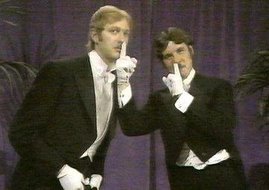
<<click here for 11/12/6 - 11/21/6>>
home about contact us featured writings years in review film productions
All rights reserved The Pink Smoke © 2008